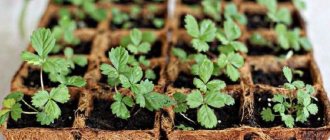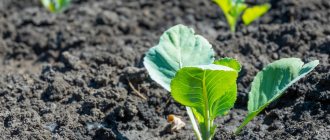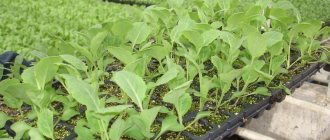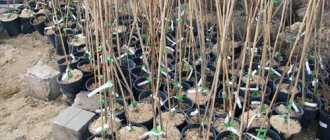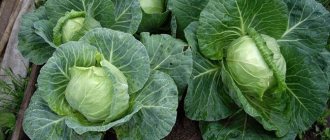Timing for planting seedlings
The right time is a prerequisite for obtaining a high-quality harvest when planting pumpkins in the ground. Gardeners are guided by their experience and acquired knowledge. Some begin to plant the plant according to the manufacturers’ recommendations, others try to focus on the lunar calendar.
According to the Lunar calendar
Days of solar and lunar eclipses are not suitable for planting. The seedlings are too sensitive at this moment, and even a slight injury can cause death.
It is recommended to focus on days that are considered favorable for planting seedlings in 2022.
It is important to use only the current calendar for the current year, and not last year’s. Because those days that were favorable last year may be prohibited in the current season.
Depending on the region
You also need to plan planting work depending on the climate of the region where the vegetable crop is grown:
- In the southern regions, you can plant melons in early May.
- In the Central regions, the landing time is shifted to mid-May.
- In the central zone, it is recommended to start planting seedlings after May 25.
- It is better to move young plants to the garden bed in Siberia and the Urals after the 20th of May, or even at the beginning of June.
When determining the planting date, you need to select the right pumpkin varieties adapted to growth and development in a given region, as well as find out all the requirements and nuances of growing the selected crop.
For planting, you need to choose a cloudy day or evening time, so the plants acclimatize better to the new place and take root faster.
Optimal planting dates
Pumpkin loves warmth: it needs a daytime temperature of +20-25 degrees and a night temperature of +18. When the thermometer drops to +14 and below, it stops growing. Both seeds and seedlings are planted outdoors after the risk of short-term spring frosts has passed. The soil temperature should not be lower than +11.
Approximate landing times are as follows:
- in the northern regions - from late spring to early June;
- in the middle zone - during the second ten days of May;
- in the south - from mid-April to mid-May.
If you are planting pumpkin seedlings, count the time for sowing seeds approximately 25-30 days before planting in the garden.
In the central and northern zones, only hard-barked varieties are grown without seedlings. Muscats are planted through seedlings even in the south, two weeks later than other varieties.
Conditions for disembarkation
When planting pumpkin seedlings in open soil, do not rush, otherwise the plants may die. Therefore, you need to make sure that all conditions for the normal growth of melons are met, and then carry out planting work:
- Optimum temperature +15-17°C. It is important to wait until warm weather sets in.
- Sufficiently dry and well-warmed soil (to a depth of 10 cm to 13-14°C).
- The age of young plants is at least 22 days.
Pumpkin prefers warm climates. This plant does not respond well to cold and high humidity. Therefore, it is important to choose the right bed for growing melons.
Neighborhood with other cultures
In small areas, plantings are organized quite closely. In this case, the question arises of how favorable this or that neighborhood is. Pumpkins, like other crops, have their suitable and unsuitable neighbors.
What to plant next to a pumpkin
When planting crops nearby in open ground, you need to take into account their requirements for conditions and care. Agricultural technology of plants should not contradict each other. When mixed plantings, be sure to make wide beds to make it easy to care for vegetables. Pumpkin's powerful roots pull nutrients and moisture from the soil, so it's important that it doesn't oppress its neighbors either.
Corn does well in the same bed with pumpkin; beans, whose roots enrich the soil with nitrogen, are also suitable as a neighbor. At the initial stages of growth, early onions and garlic are planted with the pumpkin.
Between the pumpkin beds you can plant: greens:
- parsley;
- cilantro;
- dill.
Fragrant herbs will protect the crop from pest invasion. For the greenery itself, the proximity to the pumpkin will also not be unfavorable.
What not to plant next to a pumpkin
For many plants, pumpkin will be a serious competitor in the struggle for food, light and water. A powerful vegetable can depress:
- eggplant;
- zucchini;
- cucumbers;
- cabbage;
- tomatoes;
- watermelons;
- melons;
- squash.
Proximity to pumpkin will also have an adverse effect on any low-growing vegetables. The exception is early-ripening crops, the harvest of which will be harvested by the time the pumpkin begins to actively grow.
Choosing a location on the site
Criteria for choosing a suitable site for intensive growth and development of pumpkin fruits:
- spacious, well-lit area;
- absence of drafts and protection from gusty winds;
- plain or slope, in the lowlands there is an accumulation of water, which leads to rotting of the root system;
- south orientation relative to the house;
- nutritious, crumbly, well-permeable soil with neutral acidity;
- the distance to groundwater is at least 2.5 meters.
You should not plant seedlings in a garden bed where cucumbers, zucchini, melons and watermelon previously grew. Good predecessors are potatoes, legumes, onions, and various root vegetables. Gets along well with corn, root vegetables, beans, and beans.
The best varieties
Proper harvesting is a guarantee of long-term preservation of the taste and commercial qualities of fresh pumpkin.
When choosing a pumpkin variety for planting, be sure to focus on the climate of the planting region and the characteristics of the pumpkin. In this regard, it is worth highlighting the most popular varieties.
For the Moscow region
Premiere
Cold-resistant culture from the category of table pumpkins. Represents spreading lashes. The fruits grow large, weighing about 6-7 kg. Their flesh is sweet and aromatic, like melon. The plant is unpretentious to the composition of the soil.
Common Cucurbita rero
- Common Cucurbita rero
A hard-barked species, recognized as the most capricious in terms of cultivation. Squash and zucchini are varieties of this species. It is not surprising that the Common Pumpkin has many varieties. They come in climbing and bush varieties. The fruits are also different in shape. Their weight varies between 3-7 kg. The color of the peel is orange, yellow, white or green. Some have visible stripes on the ribbed surface.
Dacha
An early ripening variety with a ripening period of about 75 days. The vegetable has a sweetish pulp with a vanilla flavor. The fruits weigh 3-4 kg and can be stored for about 4 months.
Spaghetti
An early ripening variety - it takes 2 months from germination to full ripening. After cooking, its pulp breaks up into fibers, which is why it gets its name. They are usually added to salads or eaten hot like spaghetti.
Bush orange
This representative produces large bright orange fruits, weighing about 5 kg. Their flesh is pleasantly sweet and juicy. The variety has good keeping quality.
Gribovskaya bush 189
An early fruiting variety popular among gardeners. It grows in the form of a bush, on which up to two pumpkins weighing up to 7 kg each ripen at once. They have a teardrop shape with a ribbed surface. When fully ripe, they acquire an orange-greenish color. The pulp is deep orange, dense and very sweet.
Altaiskaya 47
Refers to the universal types of early ripening. The fruits are bright orange in color with yellow stripes. The shell is hard, the flesh is fibrous and has a pronounced sweetish taste. The variety tolerates long-term transportation well and retains its original properties for a long time.
Russian
A culture resistant to cold and various fungal diseases. Valued for its sugary taste and juicy pulp. The weight of ripened fruits reaches 3 kg. Ripening time is about 110 days. Vegetables have a colorful orange color.
Nutmeg pearl
This pumpkin variety is harvested 100 days after the seeds hatch. The weight of the fetus varies from 5 to 7 kg. The pulp has a persistent nutmeg flavor. The plant is quite frost-resistant and can withstand drought and waterlogging.
Soil preparation
It is important to properly prepare the place for planting and do this better in the fall.
- Remove all debris, plant debris and weeds from the garden bed.
- Loosen the soil and after 2 weeks dig up the area, adding organic matter (manure, compost or humus) at the rate of 1 bucket of nutrient per 1 square meter. m. Fertilizers must be incorporated when digging to a depth of 20 cm.
- In the spring, after the snow has melted, to prevent the soil from drying out, it needs to be harrowed, then lightly loosened and cleared of weeds. Before planting the seedlings, dig again to a depth of 12 cm.
If the soil is heavy and wet, then it is better to make high beds that promote good soil heating.
If it was not possible to prepare the site in the fall, then fertilizers should be added to each hole at the time of planting.
How to properly store pumpkin?
In a good cellar, pumpkin retains its taste and presentable appearance all winter
Most varieties of pumpkin can be safely stored at home, maintaining their nutritional properties . But late-ripening species last longer.
It is worth noting that pumpkins have a longer shelf life than watermelons and melons.
Here are tips and recommendations on this issue:
- After harvesting in rainy weather, vegetables must be dried
- It would be great if you store the harvest in the basement, but an insulated balcony (loggia) or a cool storage room is suitable for this purpose
- Optimal conditions for long-term storage of pumpkin are a temperature range of 5-15 ᵒC and a humidity of no more than 70%
- Pumpkins are placed in wooden boxes or on racks, wrapped in plastic bags, so that they do not come into contact with each other or with the walls of the storage room. In this case, the stalks should be directed upwards
- The cut pumpkin can be placed in the refrigerator or freezer, pre-packed in food containers or bags
Preparing seedlings
It is recommended to plant pumpkin seedlings 15-20 days before moving the seedlings into open ground.
To guarantee a good harvest, it is important to adhere to the following rules:
- Keep containers in good lighting, excluding direct sunlight. Keep the temperature within +15-20°C during the day, and +12-13°C at night.
- It is recommended to water the seedlings moderately, avoiding waterlogging of the soil. It is also important to feed the plants twice. To do this, you need to dilute 1 liter of mullein, 15 grams of potassium sulfate, 15 grams of ammonium sulfate and 20 grams of superphosphate in 10 liters of water. Each seedling should receive 0.5 liters of nutritional composition.
- As the seedlings grow, the containers should be moved apart to ensure light reaches each plant.
- Before planting in the garden, hardening procedures must be carried out 5-6 days before planting. To do this, the plants are taken outside for 30 minutes on the first day, increasing the time they spend in the fresh air by 30-60 minutes every day.
Pumpkin does not tolerate picking well, so it is recommended to sow the seeds of the plant directly into separate containers.
Rules and schemes for planting pumpkin seeds in open ground
Plant pumpkin seeds in open ground according to a certain pattern. This is a large plant, so it needs a large area for nutrition. The planting pattern depends on the variety. Bush pumpkin is planted at the same distance of 70 cm in rows and row spacing, medium-stem varieties - 70 cm in a row and 1.5 m in row spacing. For pumpkin of long-stem varieties, a distance of 1 m should be left in the row between adjacent specimens, and 1.5-2 m between rows.
The depth of seed placement also matters. They are lowered into the ground 7-8 cm. Up to 3 pieces can be placed in each hole, and after shoots appear, leave 1 most developed plant and pinch the rest. Sprinkle the holes on top with a thin layer (no more than 2 cm) of humus or peat, and cover them with a light film before germination for faster germination and protection from possible spring frosts.
Along with pumpkin, you can plant corn in regular beds, and beans next to them. It is undesirable to place other pumpkin crops - zucchini, cucumbers and squash - close to pumpkins; they can become pollinated, causing the taste of their fruits to become worse.
In the northern regions, pumpkin seeds can be planted in open ground in high beds. They can be built as follows: dig a trench to the planned length and width of the beds and to a depth of 30 cm. Place plant debris at the bottom: small tree branches, leaves, sawdust, plant tops, in general, everything that can rot and give heat. Add a compost layer and a layer of soil on top. The height of such beds is at least 30 cm from the ground surface. To prevent the embankment from crumbling, you need to make fences from long pieces of slate or boards of appropriate height.
It is also popular among some gardeners to grow this crop on compost heaps, on which the plants grow well and bear fruit. The benefit is double - the pumpkin is provided with nutrients, and it itself accelerates the decomposition of plant material inside the heap, and its leaves do not allow it to dry out and prevent the growth of weeds on the heap.
Disembarkation methods
You can grow vegetables using different methods: in the garden, on trellises, in a greenhouse, in a barrel. The main thing is to choose the right pumpkin variety, and then there will be no difficulties with care and yield.
On trellises
This method allows you to save space, since the distance between the bushes with this method is reduced to 40 cm. In addition, it becomes possible to grow beautiful and even fruits.
Technology for growing pumpkins on trellises:
- Install a trellis up to 2 m in height.
- As the plant grows, the length of the vines must be pinched and excess side shoots removed.
- Stocked with reliable metal hooks. They are fixed in the place where the ovary has formed. Then they attach the whip with the fruit to the hook. This way the entire trellis will be decorated with bright and beautiful pumpkins.
- If the vegetable grows too large, the stalk on the hook may break. In this situation, a regular net will help, in which you need to place the fruits and hang them on a hook.
- Caring for a plant on a trellis is the same as in a garden bed.
This method is recommended for cultivating ornamental and muscat varieties with fruits weighing up to 4 kg. Preference should not be given to varieties that form heavier pumpkins.
To the greenhouse
With this method of planting, seeds for seedlings are sown 10 days earlier than when planting in open soil.
How to properly plant seedlings in a greenhouse:
- Make holes in the corners of the greenhouse 50 cm deep and 40 cm in diameter.
- Fill the holes with a nutritious substrate consisting of 1 bucket of humus, 1 bucket of garden soil, 1 bucket of peat with the addition of sawdust, river sand and 2 tbsp. l. nitrophoska. Prepare the mixture in a hole by mixing all the ingredients and pouring warm water at the rate of 5 liters per hole.
- Plant 2 young plants in each hole.
- When the seedlings grow to 60 cm, the film or glass in the greenhouse needs to be lifted, or cut through and direct the lashes to an area of open ground, while the roots will remain in the greenhouse.
- To get up to 3 large fruits on each plant, as well as to accelerate growth, plants must be formed into 1, 2, or 3 stems.
When cultivating vegetables in greenhouse conditions, it is important to take care of regular ventilation of the plants and know how to perform artificial pollination, otherwise you may be left without a harvest.
You can also grow pumpkin in a greenhouse this way.
In barrels
Building a pumpkin in a barrel will save space in the garden and form powerful vines. Metal tanks are suitable for this. They should be painted dark so that the substrate inside warms up well under the sun's rays.
Drainage holes should be made in the barrel to remove excess moisture. Place a rubber hose on the edges of the container to obtain soft sides.
Instructions for growing pumpkin in barrels:
- Prepare the soil mixture in the fall. Place biomass, fallen leaves, and plant tops on the bottom. Sprinkle turf and garden soil on top. In May, shed the substrate using warm water. This will start the process of decomposition of organic matter. Sprinkle humus on top.
- Plant one seedling in each barrel and pour the soil deeply.
- To speed up plant growth, it is important to provide abundant watering. There is no need to apply fertilizers, since the main part of the soil mixture is organic matter, which ensures the supply of nutrients to the melon roots.
- As the vines grow, they will move down the sides of the container. It is necessary to leave 3-4 ovaries on them and do not forget to build supports for the fruits.
Having collected the harvest, the barrel can be used next year by renewing the soil substrate.
In bags
Owners of small summer cottages often resort to tricks to arrange the required amount of vegetable crops and use dense plastic bags with a volume of 100-120 liters for these purposes. They do not take up much space, and they can be placed in any part of the garden, mounted on boards or pebbles.
Planting pumpkin seedlings in bags is carried out according to the following scheme:
- In the fall, fill the bags with a soil mixture consisting of organic matter. In spring, add humus and turf.
- Plant one seedling in each bag and water it.
- There is no need to moisten the plants in the future; rainwater will suffice.
- There is also no need to make holes; thanks to polyethylene, greenhouse conditions are created that provide heat and humidity.
When choosing to grow pumpkin in bags, it is better to give preference to bush and medium-climbing varieties of vegetable crops.
To the garden bed
This is a traditional method, which involves preparing the selected area in the fall by digging up the soil with the addition of humus at the rate of 5-6 kg per 1 sq. m. m.
Stages of planting pumpkins in the garden:
- Make holes at least 10 cm deep, maintaining intervals of 60-100 cm, moisten slightly with warm water.
- Plant seedlings, one seedling in each hole.
- Cover with nutritious soil and compact lightly.
- Mulch the plantings using peat.
Protection against pests and diseases (table)
Despite the relatively high resistance of pumpkin, if not properly cared for, it can suffer from various diseases and pests.
| Disease or pest | Description | Method of treatment |
| Powdery mildew | A very dangerous disease, as it often leads to the death of plantings. Due to high humidity combined with low temperatures, a light coating appears on the leaves and stems, which darkens a little later. The affected areas dry out and die. Pumpkin shoots slow down in growth, the fruits are poorly formed and often take on a bizarre irregular shape. The taste also suffers, so eating them becomes impossible. | All infected parts of the plant must be removed from the garden bed and burned, preferably outside the garden. The remaining shoots can be treated with colloidal sulfur at the rate of 25 g per 10 liters of water. It is also recommended to spray with a solution of 10 liters of water and 50 g of sodium phosphate or 1 liter of mullein and 3 liters of water (the latter must be infused for three days). |
| White rot | The disease becomes more active during fruit ripening. A white coating appears on the pumpkin, which gradually eats away the surface of the stems and fruits, making them unsuitable for consumption. The causative agent of white rot is a marsupial fungus, which is carried by the wind across the site and survives low temperatures well, beginning its activity when humidity rises. | All infected parts of the bush must be removed, and the remains treated with a solution of copper sulfate (5%). But it is better to take care in advance to prevent the appearance of white rot. To do this, the plantings are treated with a solution of 10 g of urea and 10 liters of warm water. |
| Bacteriosis | Initially, brown spots appear on the leaves and roots, which then begin to become wet and transform into ulcers. You cannot take seeds from such a plant, even if you pick an apparently undamaged fruit. | The disease cannot be treated, so the pumpkin will have to be dug up and burned, and the ground thoroughly disinfected. Plants that have not yet been infected must be treated with a solution of lime and copper sulfate. |
| Anthracnose or copperhead | Initially, yellow-brown spots appear on the leaves, which then turn pinkish. On fruits, they soften the surface underneath, making them unsuitable for eating. A dangerous fungus spreads through the root system, so it affects all vegetative parts of the bush. | In the first stages of the disease, spraying Bordeaux mixture (1%) will help. But if the copperhead has infested a large area, then the bush will have to be dug up and burned. Preventive measures include treating plantings with sulfur powder. In addition, it is very important not to damage the surface of the fruit when harvesting, since fungus can get inside through microcracks. To prevent the disease, you can treat the seeds with an ash solution. To prepare it, 40 g of wood ash is dissolved in 2 liters of warm water and left for a day in a dark place. After this, the resulting solution is filtered, the seeds are immersed in it for about 6 hours, and then dried. |
| Downy mildew (downy mildew) | Purple spots appear on the back side of the leaf plate, and the front side is covered with yellow spots. The leaves darken, dry out and fall off. If the spread of the disease is not stopped in time, it will affect all plantings. | Treatment procedures include treating plantings with copper oxychloride. In addition, the soil around the pumpkin should also be disinfected. To carry it out, use a solution of 10 liters of water and 40 g of oxychloride. |
| Slugs | These voracious insects multiply very quickly and begin to appear in the garden at the end of May. They begin to manifest themselves especially actively in damp, cool weather. They happily devour young leaves and ovaries that are beginning to form. If you do not actively fight them, slugs can destroy the entire crop. | Experienced gardeners place traps in their beds - wet boards, cabbage leaves or wet pieces of fabric. Slugs will certainly take a liking to them and in the morning all you have to do is just collect the pest from them. To avoid their appearance, you can sprinkle the bed with ground eggshells, lime, ash or tobacco dust. Spraying with an infusion of garlic, tomato tops, garlic or wormwood will help repel the parasite. |
| melon aphid | Aphids can be found on the back of leaves. Gradually, the parasites move onto flowers, ovaries and stems. The leaves begin to curl and then die. Pests suck out beneficial juices from the plant, which are not enough for the normal formation of fruits. Aphid activity begins in the second half of summer. | First of all, destroy all anthills that are located on the site - these insects always carry aphids with them. If the pest has already appeared on the plantings, then thoroughly treat all parts of the plant with a solution of 200 g of onion peels, 2 kg of wormwood, 50 g of household water and 10 liters of hot water, infused for 24 hours. If there are large numbers of aphids, repeated treatment may be required. If the folk remedy does not help, then you can use specialized drugs - Actellik or Karbofos. |
| Spider mite | Ticks move in large colonies and prefer to feed on fruits and leaves. Usually they take a liking to the back part of the leaves, which gradually acquire a bronze tint and then dry. The peel becomes corky, and small cracks appear on top of it. | Spider mites are quite difficult to destroy only with the help of folk remedies; you cannot do without specialized drugs. Some gardeners, when a tick appears in a greenhouse, acquire predatory insects - phytoseiulus, which eat the pests. But you will need a lot of them - from 30 to 150 individuals per 1 sq.cm. On an industrial scale, pumpkins are treated weekly with Karbofos solution. (thirty%). |
| Medvedka | The insect has a disgusting appearance and a voracious mouth. The body grows up to 7.5 cm, and the powerful jaw easily cuts through the roots and stems of plantings. It prefers to live in moist soil and winters in a manured, loose bed. Not only adult pests pose a danger to plantings, but also their larvae. | To prevent the appearance of mole crickets, it is necessary to regularly loosen the soil to a depth of 15 cm. You can place poisoned baits, which are made from chlorophos (10%) and boiled grain (90%). It is advisable to add a little more vegetable oil (30 ml). Experienced gardeners use trap nests made of humus, placed in the ground to a depth of 40 cm in the fall. There is a high probability that in the spring there will be a large family of mole crickets, which will be easy to destroy. |
Landing scheme - step-by-step instructions
When ready to plant, seedlings should be 15-22 cm high and have 3-5 true leaves.
Step by step guide:
- Make holes up to 10 cm deep. It is important to take into account that the culture needs space. Therefore, when planting bush plants, leave 55 cm, weakly branched varieties - 85 cm, and strongly climbing varieties - 125 cm.
- Add organic matter and minerals to each hole and water generously with warm water. Once the liquid is completely absorbed, you can begin planting work.
- It is necessary to replant seedlings using the transshipment method in order to avoid compromising the integrity of the root system.
- Bury the sprouts in well-moistened soil up to the cotyledon leaves.
- Lightly compact the soil and water with warm water.
- Mulch the soil in the tree trunk area with compost to prevent the growth of weeds and also prevent rotting in wet weather.
To protect seedlings from low temperatures, it is better to make a hole on small hills up to 10 cm high. It is also necessary to provide shelter in case of return frosts.
Incorrect actions when planting a melon crop in a garden bed can lead to stopping the development of the bush, not ripening the fruits and the death of the plant.
Collection and storage
By the end of summer, it's time to harvest the pumpkin. Early varieties ripen towards the end of August. Harvesting of mid-season and late-ripening varieties extends until October.
How to determine the ripeness of a pumpkin?
The end of pumpkin ripening is determined visually. By the time of full maturity, the stalk becomes hard and dry. Most of the leaves begin to turn yellow and then dry out.
The color of the skin of the fruit acquires a shade characteristic of the variety. Sometimes a peculiar pattern appears on the pumpkin. The shell thickens and becomes harder. When you knock on a ripe pumpkin, you will hear a dull sound.
Pumpkin picking
Pumpkins must be harvested before frost, even if the vegetable is slightly underripe. It is better to clean in advance; ripening will occur during storage. During harvesting, pumpkins are cut off along with the stem. The length of the tail should be at least 4-7 cm.
The cut is made with a sharp and clean knife. The pumpkin cannot be carried by holding the stem, otherwise it will break off. Before storing, the harvest is sorted, setting aside damaged and deformed specimens separately. Such pumpkins will need to be eaten first, frozen or processed.
Storage rules
The shelf life of pumpkin largely depends on the variety. An early-ripening vegetable cannot be preserved for a long time; it is processed or quickly eaten. Mid-season and late varieties can be stored in an apartment or in the basement. The room must be well ventilated. Pumpkin lasts longer without light. The optimal storage temperature is +3-15° C, humidity is no more than 80%.
Pumpkin is a very healthy vegetable that can be grown even in risky farming conditions by choosing the right variety. To get large and sweet pumpkins, the plant is cared for throughout the growing season. In the middle zone and northern regions, bushes must be formed in order for the crop to ripen.
11
Caring for seedlings after planting
The health of pumpkin bushes, their growth, development and fruiting indicators depend on the efforts spent by the gardener on basic care activities:
- maintaining constant and uniform soil moisture (water once a week, spending 15-20 liters of water per 1 sq. m.);
- providing the plant with nutrients that improve development, activate flowering, and help to form fruits faster (feed once every 2 weeks, using a solution consisting of 1 liter of mullein, 1 tablespoon of Breadwinner fertilizer);
- regular weed removal;
- loosening the root zone of the bushes so that the roots do not experience oxygen deficiency;
- mulching with sawdust and peat, which makes it possible to maintain the required level of moisture in the soil for a long time;
- periodically pinching plants after fruit set;
- systematic inspection for the appearance of diseases and pests.
In order for the fruits to ripen evenly, they must be placed in a net, which is secured to a support. If it was not possible to build a trellis, you should place roofing felt or other material that does not rot under the pumpkins.
Read more about caring for vegetables.
Selection and preparation of seeds for planting
Growing the crop begins with preparing pumpkin seeds for planting. In order for only healthy and strong plants to grow from them, you need to take only the best from the available fresh (1-4 years) planting material: large, full-bodied specimens with healthy skin, without damage or spots of rot or mold. Selecting full-fledged seeds is simple - you need to pour them into a container with salted water and wait until some of them float (it’s better not to use them, nothing good will grow from them). Empty seeds need to be removed, drained of water, and those remaining should be used for planting.
Then it is recommended to disinfect the selected specimens, germinate the seeds and harden them. First they are omitted (optional):
- for 30 minutes in a 1% solution of potassium permanganate;
- for 5 minutes in a 3% formaldehyde solution;
- for a day in a solution of potassium humate (0.5 g per 1 liter of water).
Before soaking in such solutions, you can warm the seeds in the sun for a week (they need to be stirred once a day.
After pickling, they are soaked in warm (50°C) water for 2-3 hours, wrapped in a damp cloth and left in a warm place for germination. Sprouts appear around the 3rd day.
Soaking pumpkin seeds before planting speeds up their germination, allows you to get friendly shoots, which is very important for the further development of plants, and also to some extent protects against pests that eat such seeds worse, since their taste changes.
When they begin to sprout, the seeds need to be hardened: placed in a damp cloth in a household refrigerator in the vegetable compartment for 3-4 days. Or you can germinate the seeds by combining the procedure with hardening: keep them for 10 hours at 18-20°C, then 2-3 hours at 1-2°C, then again in a warm place, etc.
Hardening off pumpkin seeds for planting is not necessary for vegetables grown in southern regions; for those that will grow in colder climates, it is recommended.
Advice from gardeners
Life hacks for planting pumpkin seedlings in the ground:
- Avoid using large seeds, as they produce powerful tops and the harvest is small in size.
- You can't plant pumpkins in the same place. You can return to the original site after 3-4 years.
- It is imperative to maintain the distance between seedlings, taking into account the requirements of each variety.
- Maintain planting depth. In the South and in the Middle Zone, it is better to place seedlings deeper, and in the North - not deepening them too much.
- Do not place melons near the pumpkin; if one crop gets sick, the entire crop will die.
- At the beginning of growth, the plant must be constantly weeded, removing weeds so that they do not draw nutrients from the soil. As the bushes grow, you don’t have to worry about weeds, they only contribute to better growth, since the pumpkin clings to them with its sprouts, which is why it better withstands gusts of wind.
Knowing the main features of cultivating melons, you can get a good harvest.
Pumpkin has many fans among gardeners. The plant is of interest both to amateur summer residents and to farmers who grow vegetables as a business. To obtain a healthy, tasty harvest of good quality, it is important to take care of timely and correct planting in open ground, and also not to forget about care.
Popular types and varieties of pumpkin
The most popular and common types and varieties of pumpkin:
- Large-fruited is the most cold-resistant species, is distinguished by large fruits, is suitable for long-term storage, but ripens later than the hard-barked variety. Popular large-fruited varieties are “Khutoryanka”, “Sweet Pie”, “Gribovskaya Zimnyaya”.
- Hardbark is the earliest ripening, unpretentious, hardy pumpkin that tolerates temperature changes well. The fruits themselves are small in size, have a hard, woody crust, and are well stored for a long time. Tastes good. Popular varieties: “Bush orange”, “Golosemyanka”, “Spaghetti”, “Altai”.
- Muscat is the most heat-loving type of pumpkin; it has the longest ripening period (i.e., late-ripening); in cold regions (Siberia, the Urals, the Moscow region) it has time to ripen only when grown through seedlings. They are considered to be the most delicious. Varieties of nutmeg pumpkin: “Pearl”, “Provencal”, “Guitar”, “Cello”.
general description
This orange vegetable is very beneficial for humans. It contains: beta-carotene, alpha-carotene, vitamins A, B, E, C, K, magnesium, calcium, manganese, iron, zinc, phosphorus, potassium.
It has been proven that pumpkin:
- cleanses the body of toxins and waste;
- stabilizes metabolism;
- normalizes high blood pressure;
- increases hemoglobin;
- increases immunity;
- improves digestion;
- evens out the glycemic profile in diabetes mellitus;
- strengthens the heart muscles and blood vessel walls;
- good for vision, even more than blueberries.
Pumpkin seeds, which have antiparasitic properties and are very beneficial for digestion, are also very useful.
A huge variety of varieties and types of pumpkins
Pumpkin is an annual plant from the melon family.
Interesting! Pumpkin is the most cold-resistant plant of all the melons. Well-rooted bushes can withstand return frosts.
Pumpkin fruits can grow up to 10 kg. The shape of the fruit is round, oval or pear-shaped. The rind of the fruit can be bright orange, light green, deep green, or grayish. The flesh of the fruit is usually bright orange, but there are varieties with amber-yellow flesh.
Growing pumpkins in open ground is not at all difficult, you just need to know the rules of agricultural technology. We will tell you about them.
Garden care
By pointing the whips at the roofs of the house or outbuilding, as well as at the fence, control them. As soon as the period of fruit ripening begins, take out insurance. A net made in the shape of a string bag, in which the pumpkin is placed, is suitable for this. The mesh must be secured with additional fasteners.
This method will protect the fruits from falling and the stems will not break. If the lashes lie on the surface of the ground, then under the fruits that have grown to medium size, place boards or some kind of material that allows air to pass through. Don't let them sit on damp ground.
Diseases and pests: control methods and prevention
Diseases that are particularly common among this vegetable crop are often bacterial and fungal. They develop due to excess moisture in the soil. Regarding the harmful insects that attack pumpkin, you can often find spider mites and aphids.
Powdery mildew is a fungal disease that affects plants, usually due to improper care. In order to cope with this disease, the plant must be sprayed with a solution made of potassium, copper sulfate and water at the rate of 3 g x 2 g x 10 l.
When the ovaries and leaves begin to form, you need to treat the bushes with Bordeaux mixture. Disease prevention involves proper watering, crop rotation and immediate removal and burning of those plants that are already diseased.
Mosaic is a virus that infects plants and quickly spreads throughout the area. If this disease is detected, it is important to immediately remove all affected bushes and burn them.
Prevention in this case means weed control, the use of only disinfected garden tools, timely measures taken to combat pests and the immediate destruction of diseased plants.
Fruit rot - if signs of rot appear, the affected areas should be cut off as quickly as possible and treated with aloe juice.
Aphids are insects that attack plants very quickly. In order to deal with it, a soap solution is suitable. You will need to dissolve 200 grams of grated soap in 10 liters of water. You can also treat the plant with 10% karbofos, diluting 60 grams in 10 liters of water. Weed control will help protect plants from attack by this pest.
Spider mites with onion infusion. To do this, add 200 grams of husk to 10 liters of water and let it brew. A solution of 20% chloroethanol also works well. It should be hung with water in the proportions of 20 g x 10 l.

